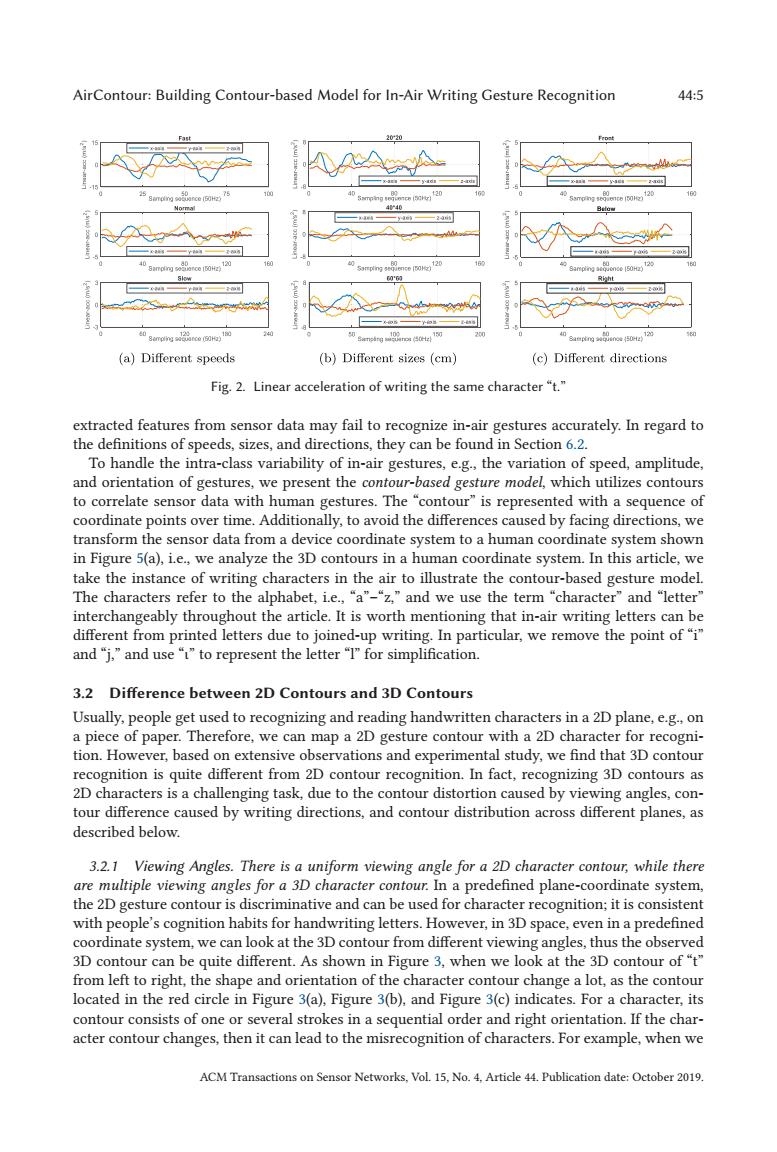正在加载图片...

AirContour:Building Contour-based Model for In-Air Writing Gesture Recognition 44:5 Fast 220 4r40 —2340 A mopiis.m 一a闪 40smp网9arm10He120 Sampsecnee50H2 Slow 0'G1 R的h礼 —n—有 (a)Different speeds (b)Different sizes (cm) (c)Different directions Fig.2.Linear acceleration of writing the same character"t." extracted features from sensor data may fail to recognize in-air gestures accurately.In regard to the definitions of speeds,sizes,and directions,they can be found in Section 6.2. To handle the intra-class variability of in-air gestures,e.g.,the variation of speed,amplitude, and orientation of gestures,we present the contour-based gesture model,which utilizes contours to correlate sensor data with human gestures.The"contour"is represented with a sequence of coordinate points over time.Additionally,to avoid the differences caused by facing directions,we transform the sensor data from a device coordinate system to a human coordinate system shown in Figure 5(a),i.e.,we analyze the 3D contours in a human coordinate system.In this article,we take the instance of writing characters in the air to illustrate the contour-based gesture model. The characters refer to the alphabet,i.e.,"a"-"z,"and we use the term"character"and "letter" interchangeably throughout the article.It is worth mentioning that in-air writing letters can be different from printed letters due to joined-up writing.In particular,we remove the point of"i" and"j,”and use“t”to represent the letter“I”for simplification. 3.2 Difference between 2D Contours and 3D Contours Usually,people get used to recognizing and reading handwritten characters in a 2D plane,e.g.,on a piece of paper.Therefore,we can map a 2D gesture contour with a 2D character for recogni- tion.However,based on extensive observations and experimental study,we find that 3D contour recognition is quite different from 2D contour recognition.In fact,recognizing 3D contours as 2D characters is a challenging task,due to the contour distortion caused by viewing angles,con- tour difference caused by writing directions,and contour distribution across different planes,as described below. 3.2.1 Viewing Angles.There is a uniform viewing angle for a 2D character contour,while there are multiple viewing angles for a 3D character contour.In a predefined plane-coordinate system, the 2D gesture contour is discriminative and can be used for character recognition;it is consistent with people's cognition habits for handwriting letters.However,in 3D space,even in a predefined coordinate system,we can look at the 3D contour from different viewing angles,thus the observed 3D contour can be quite different.As shown in Figure 3,when we look at the 3D contour of"t" from left to right,the shape and orientation of the character contour change a lot,as the contour located in the red circle in Figure 3(a),Figure 3(b),and Figure 3(c)indicates.For a character,its contour consists of one or several strokes in a sequential order and right orientation.If the char- acter contour changes,then it can lead to the misrecognition of characters.For example,when we ACM Transactions on Sensor Networks,Vol.15,No.4.Article 44.Publication date:October 2019.AirContour: Building Contour-based Model for In-Air Writing Gesture Recognition 44:5 Fig. 2. Linear acceleration of writing the same character “t.” extracted features from sensor data may fail to recognize in-air gestures accurately. In regard to the definitions of speeds, sizes, and directions, they can be found in Section 6.2. To handle the intra-class variability of in-air gestures, e.g., the variation of speed, amplitude, and orientation of gestures, we present the contour-based gesture model, which utilizes contours to correlate sensor data with human gestures. The “contour” is represented with a sequence of coordinate points over time. Additionally, to avoid the differences caused by facing directions, we transform the sensor data from a device coordinate system to a human coordinate system shown in Figure 5(a), i.e., we analyze the 3D contours in a human coordinate system. In this article, we take the instance of writing characters in the air to illustrate the contour-based gesture model. The characters refer to the alphabet, i.e., “a”–“z,” and we use the term “character” and “letter” interchangeably throughout the article. It is worth mentioning that in-air writing letters can be different from printed letters due to joined-up writing. In particular, we remove the point of “i” and “j,” and use “ι” to represent the letter “l” for simplification. 3.2 Difference between 2D Contours and 3D Contours Usually, people get used to recognizing and reading handwritten characters in a 2D plane, e.g., on a piece of paper. Therefore, we can map a 2D gesture contour with a 2D character for recognition. However, based on extensive observations and experimental study, we find that 3D contour recognition is quite different from 2D contour recognition. In fact, recognizing 3D contours as 2D characters is a challenging task, due to the contour distortion caused by viewing angles, contour difference caused by writing directions, and contour distribution across different planes, as described below. 3.2.1 Viewing Angles. There is a uniform viewing angle for a 2D character contour, while there are multiple viewing angles for a 3D character contour. In a predefined plane-coordinate system, the 2D gesture contour is discriminative and can be used for character recognition; it is consistent with people’s cognition habits for handwriting letters. However, in 3D space, even in a predefined coordinate system, we can look at the 3D contour from different viewing angles, thus the observed 3D contour can be quite different. As shown in Figure 3, when we look at the 3D contour of “t” from left to right, the shape and orientation of the character contour change a lot, as the contour located in the red circle in Figure 3(a), Figure 3(b), and Figure 3(c) indicates. For a character, its contour consists of one or several strokes in a sequential order and right orientation. If the character contour changes, then it can lead to the misrecognition of characters. For example, when we ACM Transactions on Sensor Networks, Vol. 15, No. 4, Article 44. Publication date: October 2019